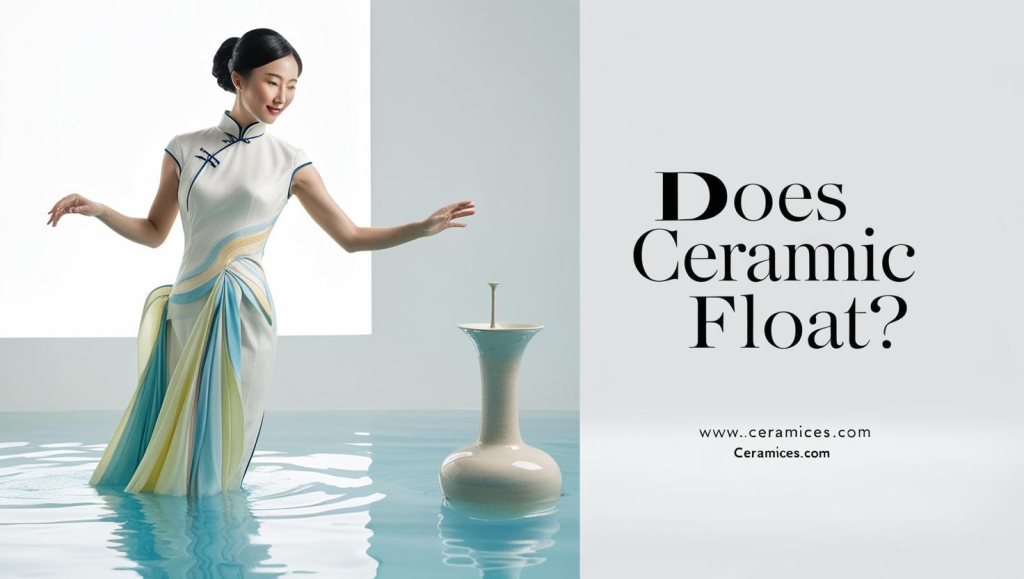Ceramic is a versatile material used in a wide range of applications, from kitchenware and bathroom tiles to decorative items and industrial components. Its durability, aesthetic appeal, and heat resistance make it a popular choice for many households and industries. However, one question that often arises is, “Does ceramic float?” The answer depends on the type of ceramic, its density, and how it’s designed. In this comprehensive guide, we’ll explore the factors that determine whether ceramic floats, the science behind buoyancy, and practical examples of floating ceramic items. We’ll also answer 10 frequently asked questions to help you better understand this fascinating material.
Understanding Ceramic: Composition and Properties
Before diving into the buoyancy of ceramic, it’s essential to understand what ceramic is made of and how it behaves under different conditions. Ceramic is a non-metallic, inorganic material typically made from clay that is fired at high temperatures. This process makes ceramic hard and durable, but its properties can vary depending on the type of clay and glaze used.
Key Characteristics of Ceramic:
- Density: Ceramic is generally dense, which affects its buoyancy.
- Porosity: Some ceramics are more porous than others, influencing their ability to float.
- Glaze: A glaze can seal the surface of ceramic, making it less porous.
Does Ceramic Float? The Answer Explained

The short answer is it depends. Whether ceramic floats or sinks depends on its density and porosity. According to the principles of buoyancy, an object will float if it is less dense than the liquid it is placed in. For ceramic, this means that its ability to float is determined by its composition and design.
Factors That Affect Ceramic’s Buoyancy:
- Density: Dense ceramics, like porcelain, are less likely to float.
- Porosity: Porous ceramics can trap air, making them more likely to float.
- Design: Hollow or lightweight ceramic items are more likely to float.
Examples of Floating Ceramic Items:
- Ceramic Foam: A lightweight, porous material used in industrial applications.
- Hollow Ceramic Decorations: Items like ceramic floats or decorative balls designed to float.
- Unglazed Pottery: Some porous, unglazed ceramics can float due to trapped air.
The Science Behind Buoyancy
Buoyancy is the force that allows objects to float in a liquid. It is determined by Archimedes’ Principle, which states that the buoyant force on an object is equal to the weight of the fluid displaced by the object. For an object to float, its average density must be less than that of the liquid.
How Buoyancy Applies to Ceramic:
- Dense Ceramics: Items like porcelain or stoneware are denser than water and will sink.
- Porous Ceramics: Items with air pockets can have a lower average density and may float.
- Hollow Ceramics: Items designed with hollow spaces can displace enough water to float.
Types of Ceramic and Their Buoyancy
Not all ceramics are created equal. Here’s a breakdown of the most common types of ceramic and their buoyancy:
1. Earthenware
- Less dense and more porous.
- More likely to float if it contains air pockets.
- Often used for decorative items and pottery.
2. Stoneware
- Denser and less porous than earthenware.
- Less likely to float.
- Commonly used for dinnerware and bakeware.
3. Porcelain
- The densest and least porous type of ceramic.
- Unlikely to float.
- Ideal for high-quality dinnerware and industrial applications.
4. Ceramic Foam
- Lightweight and highly porous.
- Designed to float.
- Used in industrial applications like filtration and insulation.
Practical Applications of Floating Ceramics
While most ceramics are dense and sink, there are practical applications for floating ceramics:
1. Ceramic Floats
- Used in fishing nets and scientific instruments.
- Designed to be buoyant and durable.
2. Decorative Items
- Hollow ceramic decorations, like floating candles or garden ornaments.
- Designed to float on water for aesthetic purposes.
3. Industrial Uses
- Ceramic foam used in filtration systems or as insulation.
- Lightweight and buoyant for specific applications.
How to Test if Ceramic Floats

If you’re curious whether a ceramic item will float, you can perform a simple test:
Step 1: Fill a Container with Water
Use a large container filled with water to test the ceramic item.
Step 2: Place the Ceramic in the Water
Gently place the ceramic item in the water and observe whether it floats or sinks.
Step 3: Check for Air Pockets
If the ceramic floats, it likely contains air pockets or is designed to be buoyant.
Benefits of Floating Ceramics
Floating ceramics offer several advantages:
- Versatility: Can be used in water-based applications like fishing or decoration.
- Durability: Ceramic is resistant to water damage and corrosion.
- Aesthetic Appeal: Floating ceramic decorations add beauty to ponds, pools, and gardens.
Risks of Using Floating Ceramics
While floating ceramics are useful, there are some risks to be aware of:
- Breakage: Ceramic can crack or shatter if dropped or mishandled.
- Weight: Some floating ceramics may become waterlogged and sink over time.
- Safety: Broken ceramic can have sharp edges, posing a safety hazard.
Tips for Using Floating Ceramics
To make the most of floating ceramics, follow these tips:
- Choose the Right Type: Select ceramics designed for buoyancy, like ceramic foam or hollow decorations.
- Handle with Care: Avoid dropping or banging ceramic items.
- Inspect Regularly: Check for cracks or damage that could affect buoyancy.
FAQs About Ceramic Buoyancy
1. Does ceramic float in water?
Most dense ceramics, like porcelain, do not float in water. However, porous or hollow ceramics can float.
2. Can I make ceramic float?
Yes, by creating hollow spaces or using porous materials, you can design ceramic items to float.
3. Why do some ceramics float?
Ceramics with air pockets or low density can float due to the principles of buoyancy.
4. Is ceramic foam buoyant?
Yes, ceramic foam is lightweight and porous, making it highly buoyant.
5. Can I use ceramic floats for fishing?
Yes, ceramic floats are commonly used in fishing nets and lines.
6. Will glazed ceramic float?
Glazed ceramic is less likely to float unless it is designed with hollow spaces.
7. How do I clean floating ceramic decorations?
Use mild soap and water to clean floating ceramics, and avoid abrasive cleaners.
8. Can I repair a broken floating ceramic item?
Small cracks can be repaired with ceramic glue, but severely damaged items may need to be replaced.
9. Are floating ceramics safe for ponds?
Yes, floating ceramics are safe for ponds and other water features.
10. What’s the best way to store floating ceramics?
Store floating ceramics in a dry, secure location to prevent damage.
Conclusion
So, does ceramic float? The answer depends on the type of ceramic, its density, and how it’s designed. While most dense ceramics like porcelain and stoneware sink, porous or hollow ceramics can float due to trapped air or low density. By understanding the principles of buoyancy and the properties of ceramic, you can determine whether a specific ceramic item will float.
Floating ceramics have practical applications in fishing, decoration, and industry, offering a unique combination of durability and functionality. Whether you’re using ceramic floats for fishing nets, decorating your garden with floating ceramic ornaments, or exploring industrial uses for ceramic foam, this versatile material continues to surprise and inspire.
With the insights and tips provided in this article, you can confidently explore the world of floating ceramics and make the most of their unique properties. Happy floating!
Read more